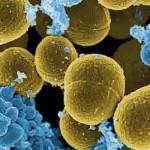
RACI Symposium – Antibacterials, Monday 9:00am
John Bremner, University of Wollongong
Matthew Cooper, University of Queensland
Multidrug resistant bacteria are a major health issue around the world and new effective drugs are clearly urgently needed.
John Bremner and his colleagues are presenting their approach to creating new antibiotics to fight against drug resistant strains of golden staph (Staphylococcus aureus) and other pathogens. They’ve created synthetic antibiotics inspired by vancomycin.
And Mathew Cooper and his colleagues at the University of Queensland have developed a novel strategy of linking an out-of-patent antibiotic, vancomycin, to small protein fragments to produce a new class of anti-bacterials.
Abstracts
J. B. Bremner
School of Chemistry, University of Wollongong, Wollongong, NSW, Australia
The resistance of human bacterial pathogenic organisms, for example strains of Staphylococcus aureus, to current antibiotics poses an increasingly serious challenge to health. A multidisciplinary approach, coupled with outside the square’ thinking, to tackling this challenge is essential.
In this talk, the design, synthesis, and biological activity of new dual action antibacterials, including berberine-based hybrid efflux pump inhibitor antibacterials,1 will be discussed.
In addition, binaphthyl-based acyclic dicationic peptoid antibacterials which may have more than one mode of action,2 will be presented, together with some reflections on future research directions including some general design criteria for possible triple action agents.
Matthew Cooper
University of Queensland, Brisbane, QLD, Australia
Multidrug resistant Gram-positive pathogens, particularly MRSA and VRE, are a major health issue around the world and new effective drugs are clearly urgently needed.
We have developed a novel strategy of linking an out-of-patent antibiotic, vancomycin, to amphiphilic peptides, based initially on the C-terminal sequence of myristoylated alanine-rich C kinase substrate (MARCKS) to produce a new class of anti-bacterials.
Several rounds of structure-activity relationship (SAR) studies produced derivatives with short peptide sequences (3-8 residues) that imparted greatly improved activities against Staphylococcus aureus (SA), epidemic methicillin-resistant S. aureus (EMRSA), glycopeptide intermediate resistant S. aureus (GISA) and Enterococcal isolates including vancomycin resistant enterococci (VRE).
Mode of action studies, which monitored the amount of radiolabeled [14C]UDP-GlcNAc incorporated into lipid II and mature peptidoglycan with increasing concentrations of antibiotic, indicate that the compounds not only inhibit the transpeptidation step (as is the case for vancomycin) but also the transglycosylation step (i.e. inhibit formation of Lipid II).
Evidence will also be presented to demonstrate that the compounds bind and destabilize the bacterial membrane, while the peptides themselves only showed weak antibacterial activity.

